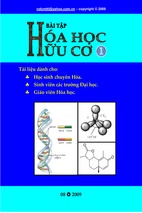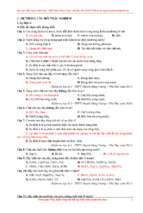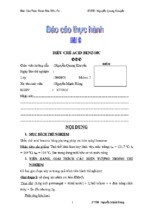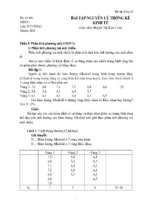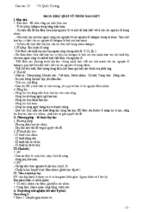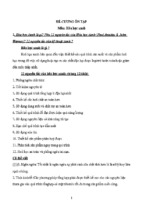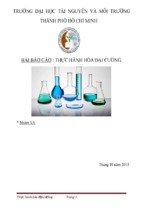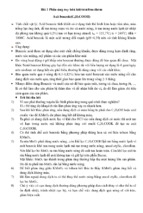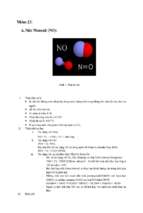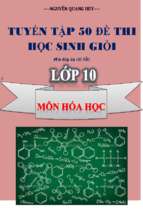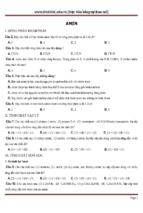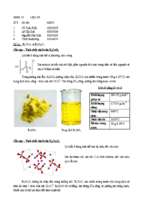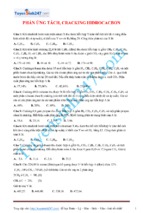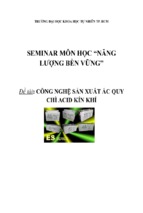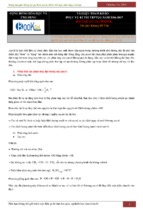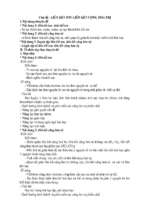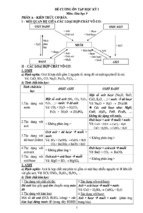Chemistry Workbook For Dummies - Peter J. Mikulecky PhD, Katherine Brutlag, Michelle Rose Gilman, Brian Peterson
Chemistr y
Workbook
FOR
DUMmIES
‰
by Peter J. Mikulecky, PhD, Katherine Brutlag,
Michelle Rose Gilman, and Brian Peterson
Chemistry Workbook For Dummies®
Published by
Wiley Publishing, Inc.
111 River St.
Hoboken, NJ 07030-5774
www.wiley.com
Copyright © 2008 by Wiley Publishing, Inc., Indianapolis, Indiana
Published simultaneously in Canada
No part of this publication may be reproduced, stored in a retrieval system, or transmitted in any form or by any
means, electronic, mechanical, photocopying, recording, scanning, or otherwise, except as permitted under Sections
107 or 108 of the 1976 United States Copyright Act, without either the prior written permission of the Publisher, or
authorization through payment of the appropriate per-copy fee to the Copyright Clearance Center, 222 Rosewood
Drive, Danvers, MA 01923, 978-750-8400, fax 978-646-8600. Requests to the Publisher for permission should be
addressed to the Legal Department, Wiley Publishing, Inc., 10475 Crosspoint Blvd., Indianapolis, IN 46256,
317-572-3447, fax 317-572-4355, or online at http://www.wiley.com/go/permissions.
Trademarks: Wiley, the Wiley Publishing logo, For Dummies, the Dummies Man logo, A Reference for the Rest of Us!,
The Dummies Way, Dummies Daily, The Fun and Easy Way, Dummies.com and related trade dress are trademarks or
registered trademarks of John Wiley & Sons, Inc. and/or its affiliates in the United States and other countries, and may
not be used without written permission. All other trademarks are the property of their respective owners. Wiley
Publishing, Inc., is not associated with any product or vendor mentioned in this book.
LIMIT OF LIABILITY/DISCLAIMER OF WARRANTY: THE PUBLISHER AND THE AUTHOR MAKE NO REPRESENTATIONS OR WARRANTIES WITH RESPECT TO THE ACCURACY OR COMPLETENESS OF THE CONTENTS OF THIS
WORK AND SPECIFICALLY DISCLAIM ALL WARRANTIES, INCLUDING WITHOUT LIMITATION WARRANTIES OF FITNESS FOR A PARTICULAR PURPOSE. NO WARRANTY MAY BE CREATED OR EXTENDED BY SALES OR PROMOTIONAL MATERIALS. THE ADVICE AND STRATEGIES CONTAINED HEREIN MAY NOT BE SUITABLE FOR EVERY
SITUATION. THIS WORK IS SOLD WITH THE UNDERSTANDING THAT THE PUBLISHER IS NOT ENGAGED IN RENDERING LEGAL, ACCOUNTING, OR OTHER PROFESSIONAL SERVICES. IF PROFESSIONAL ASSISTANCE IS
REQUIRED, THE SERVICES OF A COMPETENT PROFESSIONAL PERSON SHOULD BE SOUGHT. NEITHER THE PUBLISHER NOR THE AUTHOR SHALL BE LIABLE FOR DAMAGES ARISING HEREFROM. THE FACT THAT AN ORGANIZATION OR WEBSITE IS REFERRED TO IN THIS WORK AS A CITATION AND/OR A POTENTIAL SOURCE OF
FURTHER INFORMATION DOES NOT MEAN THAT THE AUTHOR OR THE PUBLISHER ENDORSES THE INFORMATION THE ORGANIZATION OR WEBSITE MAY PROVIDE OR RECOMMENDATIONS IT MAY MAKE. FURTHER, READERS SHOULD BE AWARE THAT INTERNET WEBSITES LISTED IN THIS WORK MAY HAVE CHANGED OR
DISAPPEARED BETWEEN WHEN THIS WORK WAS WRITTEN AND WHEN IT IS READ.
For general information on our other products and services, please contact our Customer Care Department within the
U.S. at 800-762-2974, outside the U.S. at 317-572-3993, or fax 317-572-4002.
For technical support, please visit www.wiley.com/techsupport.
Wiley also publishes its books in a variety of electronic formats. Some content that appears in print may not be available in electronic books.
Library of Congress Control Number: 2008929976
ISBN: 978-0-470-25152-2
Manufactured in the United States of America
10 9 8 7 6 5 4 3 2 1
Chemistr y
Workbook
FOR
DUMmIES
‰
by Peter J. Mikulecky, PhD, Katherine Brutlag,
Michelle Rose Gilman, and Brian Peterson
Chemistry Workbook For Dummies®
Published by
Wiley Publishing, Inc.
111 River St.
Hoboken, NJ 07030-5774
www.wiley.com
Copyright © 2008 by Wiley Publishing, Inc., Indianapolis, Indiana
Published simultaneously in Canada
No part of this publication may be reproduced, stored in a retrieval system, or transmitted in any form or by any
means, electronic, mechanical, photocopying, recording, scanning, or otherwise, except as permitted under Sections
107 or 108 of the 1976 United States Copyright Act, without either the prior written permission of the Publisher, or
authorization through payment of the appropriate per-copy fee to the Copyright Clearance Center, 222 Rosewood
Drive, Danvers, MA 01923, 978-750-8400, fax 978-646-8600. Requests to the Publisher for permission should be
addressed to the Legal Department, Wiley Publishing, Inc., 10475 Crosspoint Blvd., Indianapolis, IN 46256,
317-572-3447, fax 317-572-4355, or online at http://www.wiley.com/go/permissions.
Trademarks: Wiley, the Wiley Publishing logo, For Dummies, the Dummies Man logo, A Reference for the Rest of Us!,
The Dummies Way, Dummies Daily, The Fun and Easy Way, Dummies.com and related trade dress are trademarks or
registered trademarks of John Wiley & Sons, Inc. and/or its affiliates in the United States and other countries, and may
not be used without written permission. All other trademarks are the property of their respective owners. Wiley
Publishing, Inc., is not associated with any product or vendor mentioned in this book.
LIMIT OF LIABILITY/DISCLAIMER OF WARRANTY: THE PUBLISHER AND THE AUTHOR MAKE NO REPRESENTATIONS OR WARRANTIES WITH RESPECT TO THE ACCURACY OR COMPLETENESS OF THE CONTENTS OF THIS
WORK AND SPECIFICALLY DISCLAIM ALL WARRANTIES, INCLUDING WITHOUT LIMITATION WARRANTIES OF FITNESS FOR A PARTICULAR PURPOSE. NO WARRANTY MAY BE CREATED OR EXTENDED BY SALES OR PROMOTIONAL MATERIALS. THE ADVICE AND STRATEGIES CONTAINED HEREIN MAY NOT BE SUITABLE FOR EVERY
SITUATION. THIS WORK IS SOLD WITH THE UNDERSTANDING THAT THE PUBLISHER IS NOT ENGAGED IN RENDERING LEGAL, ACCOUNTING, OR OTHER PROFESSIONAL SERVICES. IF PROFESSIONAL ASSISTANCE IS
REQUIRED, THE SERVICES OF A COMPETENT PROFESSIONAL PERSON SHOULD BE SOUGHT. NEITHER THE PUBLISHER NOR THE AUTHOR SHALL BE LIABLE FOR DAMAGES ARISING HEREFROM. THE FACT THAT AN ORGANIZATION OR WEBSITE IS REFERRED TO IN THIS WORK AS A CITATION AND/OR A POTENTIAL SOURCE OF
FURTHER INFORMATION DOES NOT MEAN THAT THE AUTHOR OR THE PUBLISHER ENDORSES THE INFORMATION THE ORGANIZATION OR WEBSITE MAY PROVIDE OR RECOMMENDATIONS IT MAY MAKE. FURTHER, READERS SHOULD BE AWARE THAT INTERNET WEBSITES LISTED IN THIS WORK MAY HAVE CHANGED OR
DISAPPEARED BETWEEN WHEN THIS WORK WAS WRITTEN AND WHEN IT IS READ.
For general information on our other products and services, please contact our Customer Care Department within the
U.S. at 800-762-2974, outside the U.S. at 317-572-3993, or fax 317-572-4002.
For technical support, please visit www.wiley.com/techsupport.
Wiley also publishes its books in a variety of electronic formats. Some content that appears in print may not be available in electronic books.
Library of Congress Control Number: 2008929976
ISBN: 978-0-470-25152-2
Manufactured in the United States of America
10 9 8 7 6 5 4 3 2 1
About the Authors
Peter Mikulecky grew up in Milwaukee, an area of Wisconsin unique for its high humanto-cow ratio. After a breezy four-year tour in the Army, Peter earned a bachelor of science
degree in biochemistry and molecular biology from the University of Wisconsin–
Eau Claire and a PhD in biological chemistry from Indiana University. With science
seething in his DNA, he sought to infect others with a sense of molecular wonderment.
Having taught, tutored, and mentored in classroom and laboratory environments, Peter
was happy to find a home at Fusion Learning Center and Fusion Academy. There, he
enjoys convincing students that biology and chemistry are, in fact, fascinating journeys,
not entirely designed to inflict pain on hapless teenagers. His military training occasionally aids him in this effort.
Katherine (Kate) Brutlag has been a full-fledged science dork since she picked up her
first book on dinosaurs as a child. A native of Minnesota, Kate enjoys typical regional
activities such as snow sports and cheese eating. Kate left Minnesota as a teen to study
at Middlebury College in Vermont and graduated with a double major in physics and
Japanese. Seeking to unite these two highly unrelated passions, she spent a year in
Kyoto, Japan, on a Fulbright scholarship researching Japanese constellation lore. Kate
was quickly drawn back to the pure sciences, however, and she discovered her love for
education through her work at Fusion Academy, where she currently teaches upper-level
sciences and Japanese.
Michelle Rose Gilman is most proud to be known as Noah’s mom. A graduate of the
University of South Florida, Michelle found her niche early, and at 19, she was working
with emotionally disturbed and learning-disabled students in hospital settings. At 21,
she made the trek to California, where she found her passion for helping teenagers
become more successful in school and life. What started as a small tutoring business in
the garage of her California home quickly expanded and grew to the point where traffic
control was necessary on her residential street.
Today, Michelle is the founder and CEO of Fusion Learning Center and Fusion Academy,
a private school and tutoring/test prep facility in Solana Beach, California, serving more
than 2,000 students per year. She is the author of ACT For Dummies, Pre-Calculus For
Dummies, AP Biology For Dummies, AP Chemistry For Dummies, GRE For Dummies, and
other books on self-esteem, writing, and motivational topics. Michelle has overseen
dozens of programs over the last 20 years, focusing on helping kids become healthy
adults. She currently specializes in motivating the unmotivated adolescent, comforting
their shell-shocked parents, and assisting her staff of 35 teachers.
Michelle lives by the following motto: There are people content with longing; I am not
one of them.
Brian Peterson remembers a love for science going back to his own AP Biology class.
At the University of San Diego, Brian majored in biology and minored in chemistry, with
a pre-med emphasis. Before embarking to medical school, Brian took a young adult–
professional detour and found himself at Fusion Learning Center and Fusion Academy,
where he quickly discovered a love of teaching. Years later, he finds himself the science
department head at Fusion and oversees a staff of 11 science teachers. Brian, also known
as “Beeps” by his favorite students, encourages the love of science in his students by
offering unique and innovative science curricula.
Dedication
We would like to dedicate this book to our families and friends who supported us during
the writing process. Also, to all our students who motivate us to be better teachers by
pushing us to find unique and fresh ways to reach them.
Authors’ Acknowledgments
Thanks to Bill Gladstone from Waterside Productions for being an amazing agent and
friend. Thanks to Georgette Beatty, our project editor, for her clear feedback and support. A special shout-out to our acquisitions editor, Lindsay Lefevere, who, for reasons
unclear, seems to keep wanting to work with us. Acknowledgments also to our copy
editor, Vicki Adang, and technical reviewer Michael Edwards.
Publisher’s Acknowledgments
We’re proud of this book; please send us your comments through our Dummies online registration form located
at www.dummies.com/register/.
Some of the people who helped bring this book to market include the following:
Acquisitions, Editorial, and Media Development
Composition Services
Project Editor: Georgette Beatty
Project Coordinator: Katherine Key
Acquisitions Editor: Lindsay Sandman Lefevere
Layout and Graphics: Carl Byers, Melanee Habig,
Joyce Haughey, Laura Pence
Senior Copy Editor: Victoria M. Adang
Editorial Program Coordinator:
Erin Calligan Mooney
Proofreaders: Arielle Carole Mennelle
Indexer: Steve Rath
Technical Editor: Michael A. Edwards, PhD
Editorial Manager: Michelle Hacker
Editorial Assistants: Joe Niesen, Jennette ElNaggar
Cover Photo: Ty Milford
Cartoons: Rich Tennant (www.the5thwave.com)
Publishing and Editorial for Consumer Dummies
Diane Graves Steele, Vice President and Publisher, Consumer Dummies
Joyce Pepple, Acquisitions Director, Consumer Dummies
Kristin A. Cocks, Product Development Director, Consumer Dummies
Michael Spring, Vice President and Publisher, Travel
Kelly Regan, Editorial Director, Travel
Publishing for Technology Dummies
Andy Cummings, Vice President and Publisher, Dummies Technology/General User
Composition Services
Gerry Fahey, Vice President of Production Services
Debbie Stailey, Director of Composition Services
Contents at a Glance
Introduction .............................................................................1
Part I: Getting Cozy with Numbers, Atoms, and Elements ............7
Chapter 1: Noting Numbers Scientifically...........................................................................................9
Chapter 2: Using and Converting Units.............................................................................................21
Chapter 3: Organizing Matter into Atoms and Phases ....................................................................33
Chapter 4: Surveying the Periodic Table of the Elements ..............................................................49
Part II: Making and Remaking Compounds...............................63
Chapter 5: Building Bonds ..................................................................................................................65
Chapter 6: Naming Compounds .........................................................................................................85
Chapter 7: Managing the Mighty Mole ..............................................................................................97
Chapter 8: Getting a Grip on Chemical Equations .........................................................................111
Chapter 9: Putting Stoichiometry to Work .....................................................................................125
Part III: Examining Changes in Terms of Energy......................141
Chapter 10: Understanding States in Terms of Energy .................................................................143
Chapter 11: Obeying Gas Laws.........................................................................................................151
Chapter 12: Dissolving into Solutions .............................................................................................163
Chapter 13: Playing Hot and Cold: Colligative Properties ............................................................175
Chapter 14: Exploring Rate and Equilibrium..................................................................................187
Chapter 15: Warming Up to Thermochemistry..............................................................................201
Part IV: Swapping Charges ...................................................213
Chapter 16: Giving Acids and Bases the Litmus Test....................................................................215
Chapter 17: Achieving Neutrality with Equivalents, Titration, and Buffers ...............................227
Chapter 18: Accounting for Electrons in Redox.............................................................................239
Chapter 19: Galvanizing Yourself into Electrochemistry..............................................................249
Chapter 20: Doing Chemistry with Atomic Nuclei.........................................................................263
Part V: Going Organic...........................................................271
Chapter 21: Making Chains with Carbon ........................................................................................273
Chapter 22: Seeing Isomers in Stereo..............................................................................................289
Chapter 23: Moving through the Functional Groups.....................................................................301
Part VI: The Part of Tens .......................................................319
Chapter 24: Ten Formulas to Tattoo on Your Brain.......................................................................321
Chapter 25: Ten Annoying Exceptions to Chemistry Rules..........................................................327
Index ...................................................................................333
Table of Contents
Introduction..............................................................................1
About This Book ..................................................................................................................1
Conventions Used in This Book.........................................................................................1
Foolish Assumptions...........................................................................................................2
How This Book Is Organized ..............................................................................................2
Part I: Getting Cozy with Numbers, Atoms, and Elements ...................................2
Part II: Making and Remaking Compounds.............................................................2
Part III: Examining Changes in Terms of Energy ....................................................3
Part IV: Swapping Charges........................................................................................3
Part V: Going Organic ................................................................................................3
Part VI: The Part of Tens...........................................................................................3
Icons Used in This Book .....................................................................................................4
Where to Go from Here .......................................................................................................4
Part I: Getting Cozy with Numbers, Atoms, and Elements.............7
Chapter 1: Noting Numbers Scientifically ...................................................................9
Using Exponential and Scientific Notation to Report Measurements...........................9
Multiplying and Dividing in Scientific Notation .............................................................11
Using Exponential Notation to Add and Subtract .........................................................12
Distinguishing between Accuracy and Precision ..........................................................14
Expressing Precision with Significant Figures ...............................................................15
Doing Arithmetic with Significant Figures ......................................................................17
Answers to Questions on Noting Numbers Scientifically.............................................19
Chapter 2: Using and Converting Units.......................................................................21
Familiarizing Yourself with Base Units and Metric System Prefixes ...........................21
Building Derived Units from Base Units .........................................................................23
Converting between Units: The Conversion Factor ......................................................24
Letting the Units Guide You .............................................................................................28
Answers to Questions on Using and Converting Units.................................................31
Chapter 3: Organizing Matter into Atoms and Phases.............................................33
Building Atoms from Subatomic Particles .....................................................................33
J. J. Thomson: Cooking up the “plum pudding” model.......................................35
Ernest Rutherford: Shooting at gold......................................................................35
Niels Bohr: Comparing the atom to the solar system .........................................36
Deciphering Chemical Symbols: Atomic and Mass Numbers ......................................37
Accounting for Isotopes Using Atomic Masses .............................................................40
Moving between the Phases of Solids, Liquids, and Gases..........................................42
Answers to Questions on Organizing Matter .................................................................46
Chapter 4: Surveying the Periodic Table of the Elements.......................................49
Reading Periods and Groups in the Periodic Table ......................................................49
Predicting Properties from Periodic and Group Trends...............................................52
x
Chemistry Workbook For Dummies
Seeking Stability with Valence Electrons by Forming Ions...........................................54
Putting Electrons in Their Places: Electron Configurations.........................................56
Measuring the Amount of Energy (Or Light) an Excited Electron Emits....................59
Answers to Questions on the Periodic Table.................................................................61
Part II: Making and Remaking Compounds ...............................63
Chapter 5: Building Bonds ............................................................................................65
Pairing Charges with Ionic Bonds....................................................................................66
Sharing Charge with Covalent Bonds..............................................................................68
Occupying and Overlapping Molecular Orbitals...........................................................72
Tugging on Electrons within Bonds: Polarity.................................................................74
Shaping Molecules: VSEPR Theory and Hybridization.................................................77
Answers to Questions on Bonds .....................................................................................82
Chapter 6: Naming Compounds....................................................................................85
Naming Ionic Compounds ................................................................................................85
Dealing with Those Pesky Polyatomic Ions ...................................................................87
Giving Monikers to Molecular Compounds....................................................................89
Seeing the Forest: A Unified Scheme for Naming Compounds ....................................91
Answers to Questions on Naming Compounds .............................................................94
Chapter 7: Managing the Mighty Mole.......................................................................97
Counting Your Particles: The Mole..................................................................................97
Assigning Mass and Volume to Moles.............................................................................99
Giving Credit Where It’s Due: Percent Composition ...................................................102
Moving from Percent Composition to Empirical Formulas........................................103
Moving from Empirical Formulas to Molecular Formulas..........................................105
Answers to Questions on Moles ....................................................................................107
Chapter 8: Getting a Grip on Chemical Equations ..................................................111
Translating Chemistry into Equations and Symbols ..................................................111
Making Your Chemical Equations True by Balancing .................................................113
Recognizing Reactions and Predicting Products.........................................................116
Combination ...........................................................................................................116
Decomposition .......................................................................................................116
Single replacement ................................................................................................117
Double replacement ..............................................................................................118
Combustion ............................................................................................................118
Getting Rid of Mere Spectators: Net Ionic Equations..................................................120
Answers to Questions on Chemical Equations............................................................122
Chapter 9: Putting Stoichiometry to Work ...............................................................125
Using Mole-Mole Conversions from Balanced Equations...........................................125
Putting Moles at the Center: Conversions Involving Particles,
Volumes, and Masses ..................................................................................................128
Limiting Your Reagents ...................................................................................................130
Counting Your Chickens after They’ve Hatched: Percent Yield Calculations..........133
Answers to Questions on Stoichiometry......................................................................135
Table of Contents
Part III: Examining Changes in Terms of Energy ......................141
Chapter 10: Understanding States in Terms of Energy...........................................143
Describing States of Matter with Kinetic Theory ........................................................143
Make a Move: Figuring Out Phase Transitions and Diagrams ...................................146
Discerning Differences in Solid States ..........................................................................148
Answers to Questions on Changes of State..................................................................150
Chapter 11: Obeying Gas Laws...................................................................................151
Getting the Vapors: Evaporation and Vapor Pressure ................................................152
Playing with Pressure and Volume: Boyle’s Law .........................................................153
Tinkering with Volume and Temperature: Charles’s Law and Absolute Zero..........155
All Together Now: The Combined and Ideal Gas Laws ...............................................156
Mixing It Up with Dalton’s Law of Partial Pressures ...................................................158
Diffusing and Effusing with Graham’s Law ...................................................................159
Answers to Questions on Gas Laws ..............................................................................161
Chapter 12: Dissolving into Solutions.......................................................................163
Seeing Different Forces at Work in Solubility ...............................................................163
Altering Solubility with Temperature............................................................................165
Concentrating on Molarity and Percent Solutions ......................................................168
Changing Concentrations by Making Dilutions ...........................................................170
Answers to Questions on Solutions ..............................................................................172
Chapter 13: Playing Hot and Cold: Colligative Properties.....................................175
Portioning Particles: Molality and Mole Fractions......................................................175
Too Hot to Handle: Elevating and Calculating Boiling Points ....................................178
How Low Can You Go? Depressing and Calculating Freezing Points ........................180
Determining Molecular Masses with Boiling and Freezing Points ............................182
Answers to Questions on Colligative Properties.........................................................184
Chapter 14: Exploring Rate and Equilibrium............................................................187
Measuring Rates ..............................................................................................................187
Focusing on Factors that Affect Rates ..........................................................................191
Measuring Equilibrium....................................................................................................193
The equilibrium constant .....................................................................................194
Free energy .............................................................................................................194
Checking Out Factors that Disrupt Equilibrium ..........................................................197
Answers to Questions on Rate and Equilibrium..........................................................199
Chapter 15: Warming Up to Thermochemistry ........................................................201
Working with the Basics of Thermodynamics .............................................................201
Holding Heat: Heat Capacity and Calorimetry.............................................................203
Absorbing and Releasing Heat: Endothermic and Exothermic Reactions ...............206
Summing Heats with Hess’s Law ...................................................................................208
Answers to Questions on Thermochemistry ...............................................................211
xi
xii
Chemistry Workbook For Dummies
Part IV: Swapping Charges ....................................................213
Chapter 16: Giving Acids and Bases the Litmus Test.............................................215
Three Complementary Methods for Defining Acids and Bases.................................215
Method 1: Arrhenius sticks to the basics ...........................................................215
Method 2: Brønsted-Lowry tackles bases without a hydroxide ion................216
Method 3: Lewis relies on electron pairs............................................................217
Measuring Acidity and Basicity: pH, pOH, and Kw ......................................................219
Finding Strength through Dissociation: Ka and Kb ......................................................222
Answers to Questions on Acids and Bases ..................................................................224
Chapter 17: Achieving Neutrality with Equivalents, Titration, and Buffers.......227
Examining Equivalents and Normality..........................................................................228
Concentrating on Titration to Figure Out Molarity .....................................................230
Maintaining Your pH with Buffers .................................................................................233
Measuring Salt Solubility: Ksp ........................................................................................235
Answers to Questions on Neutralizing Equivalents....................................................237
Chapter 18: Accounting for Electrons in Redox ......................................................239
Keeping Tabs on Electrons with Oxidation Numbers .................................................239
Balancing Redox Reactions under Acidic Conditions.................................................242
Balancing Redox Reactions under Basic Conditions ..................................................244
Answers to Questions on Electrons in Redox..............................................................246
Chapter 19: Galvanizing Yourself into Electrochemistry.......................................249
Identifying Anodes and Cathodes .................................................................................249
Calculating Electromotive Force and Standard Reduction Potentials......................252
Coupling Current to Chemistry: Electrolytic Cells ......................................................256
Answers to Questions on Electrochemistry ................................................................259
Chapter 20: Doing Chemistry with Atomic Nuclei..................................................263
Decaying Nuclei in Different Ways.................................................................................263
Alpha decay ............................................................................................................263
Beta decay ..............................................................................................................264
Gamma decay .........................................................................................................264
Measuring Rates of Decay: Half-Lives ...........................................................................266
Making and Breaking Nuclei: Fusion and Fission ........................................................267
Answers to Questions on Nuclear Chemistry..............................................................269
Part V: Going Organic ...........................................................271
Chapter 21: Making Chains with Carbon..................................................................273
Single File Now: Linking Carbons into Continuous Alkanes.......................................273
Going Out on a Limb: Making Branched Alkanes by Substitution ............................276
Getting Unsaturated: Alkenes and Alkynes ..................................................................280
Rounding ’em Up: Circular Carbon Chains...................................................................282
Wrapping your head around cyclic aliphatic hydrocarbons ...........................282
Sniffing out aromatic hydrocarbons....................................................................283
Answers to Questions on Carbon Chains.....................................................................285
Table of Contents
Chapter 22: Seeing Isomers in Stereo.......................................................................289
Picking Sides with Geometric Isomers..........................................................................289
Alkenes: Keen on cis-trans configurations .........................................................290
Alkanes that aren’t straight-chain: Making a ringside bond.............................290
Alkynes: No place to create stereoisomers ........................................................291
Staring into the Mirror with Enantiomers and Diastereomers ..................................293
Getting a grip on chirality.....................................................................................293
Depicting enantiomers and diastereomers in Fischer projections .................294
Answers to Questions on Stereoisomers......................................................................299
Chapter 23: Moving through the Functional Groups...............................................301
Meeting the Cast of Chemical Players ..........................................................................301
Alcohols: Hosting a hydroxide .............................................................................303
Ethers: Invaded by oxygen ...................................................................................303
Carboxylic acids: –COOH brings up the rear .....................................................304
Esters: Creating two carbon chains.....................................................................304
Aldehydes: Holding tight to one oxygen.............................................................305
Ketones: Lone oxygen sneaks up the chain .......................................................305
Halocarbons: Hello, halogens!..............................................................................306
Amines: Hobnobbing with nitrogen.....................................................................306
Reacting by Substitution and Addition.........................................................................309
Seeing Chemistry at Work in Biology ............................................................................311
Carbohydrates: Carbon meets water ..................................................................311
Proteins: Built from amino acids..........................................................................312
Nucleic acids: The backbones of life ...................................................................313
Answers to Questions on Functional Groups ..............................................................316
Part VI: The Part of Tens........................................................319
Chapter 24: Ten Formulas to Tattoo on Your Brain..................................................321
The Combined Gas Law ..................................................................................................321
Dalton’s Law of Partial Pressures ..................................................................................322
The Dilution Equation .....................................................................................................322
Rate Laws..........................................................................................................................322
The Equilibrium Constant ..............................................................................................323
Free Energy Change.........................................................................................................323
Constant-Pressure Calorimetry .....................................................................................324
Hess’s Law ........................................................................................................................324
pH, pOH, and Kw ..............................................................................................................324
Ka and Kb...........................................................................................................................325
Chapter 25: Ten Annoying Exceptions to Chemistry Rules ...................................327
Hydrogen Isn’t an Alkali Metal .......................................................................................327
The Octet Rule Isn’t Always an Option.........................................................................327
Some Electron Configurations Ignore the Orbital Rules.............................................328
One Partner in Coordinate Covalent Bonds Giveth Electrons; the Other Taketh ....329
All Hybridized Orbitals Are Created Equal...................................................................329
Use Caution When Naming Compounds with Transition Metals ..............................330
xiii
xiv
Chemistry Workbook For Dummies
You Must Memorize Polyatomic Ions............................................................................330
Liquid Water Is Denser than Ice.....................................................................................331
No Gas Is Truly Ideal .......................................................................................................331
Common Names for Organic Compounds Hearken Back to the Old Days...............332
Index....................................................................................333
Introduction
“T
he first essential in chemistry is that you should perform practical work and conduct
experiments, for he who performs not practical work nor makes experiments will never
attain the least degree of mastery.”
—J≈bir ibn Hayy≈n, 8th century
“One of the wonders of this world is that objects so small can have such consequences: Any
visible lump of matter — even the merest speck — contains more atoms than there are stars
in our galaxy.”
—Peter W. Atkins, 20th century
Chemistry is at once practical and wondrous, humble and majestic. And, for someone studying it for the first time, chemistry can be tricky.
That’s why we wrote this book. Chemistry is wondrous. Workbooks are practical. This is a
chemistry workbook.
About This Book
When you’re fixed in the thickets of stoichiometry or bogged down by buffered solutions,
you’ve got little use for rapturous poetry about the atomic splendor of the universe. What
you need is a little practical assistance. Subject by subject, problem by problem, this book
extends a helping hand to pull you out of the thickets and bogs.
The topics covered in this book are those most often covered in a first course of chemistry.
The focus is on problems — problems like those you may encounter in homework or on
exams. We give you just enough theory to grasp the principles at work in the problems. Then
we tackle example problems. Then you tackle practice problems.
This workbook is modular. You can pick and choose those chapters and types of problems
that challenge you the most; you don’t have to read this book cover to cover if you don’t
want to. If certain topics require you to know other topics in advance, we tell you so and
point you in the right direction. Most importantly, worked-out solutions and explanations are
provided for every problem.
Conventions Used in This Book
We provide the following conventions to guide you through this book:
� Italics highlight definitions, emphasize certain words, and point out variables in formulas.
� Boldfaced text points out key words in bulleted lists and actions to take in numbered lists.
2
Chemistry Workbook For Dummies
Foolish Assumptions
We assume you have a basic facility with algebra and arithmetic. You should know how
to solve simple equations for an unknown variable. You should know how to work with
exponents and logarithms. That’s about it for the math. At no point do we ask you to, say,
consider the contradictions between the Schrödinger equation and stochastic wavefunction
collapse.
We assume you’re a high school or college student and have access to a secondary schoollevel (or higher) textbook in chemistry or some other basic primer, such as Chemistry For
Dummies (written by John T. Moore, EdD, and published by Wiley). We present enough
theory in this workbook for you to tackle the problems, but you’ll benefit from a broader
description of basic chemical concepts. That way, you’ll more clearly understand how the
various pieces of chemistry operate within a larger whole — you’ll see the compound for the
elements, so to speak.
We assume you don’t like to waste time. Neither do we. Chemists in general aren’t too fond of
time-wasting, so if you’re impatient for progress, you’re already part-chemist at heart.
How This Book Is Organized
This workbook is divided into thematic parts. By no means is it absolutely necessary to consume all the chapters of a part in sequence, nor is it necessary to progress in a straight line
from one part to the next. But it may be useful to do so, especially if you’re starting from a
place of Total Chemical Bewilderment (T.C.B.).
Part I: Getting Cozy with Numbers,
Atoms, and Elements
Chemists are part of a larger scientific enterprise, so they handle numbers with care and
according to certain rules. The reasons for this meticulousness become clear as you consider the kinds of measurements chemists routinely make on very large numbers of particles.
The most familiar of these kinds of chemical particles are atoms. This part covers some
must-know material about numbers in chemistry, describes the basic structure of atoms,
outlines how atoms belong to one or another variety of element, and explains how atoms
interact within different states of matter.
Part II: Making and Remaking Compounds
Reactions are the dramatic deeds of chemistry. By reacting, atoms assemble into compounds,
and compounds transform into other compounds. This part gives you the basic tools to
describe the drama. We explain the basics of bonding and the system for naming compounds.
We introduce you to the mole, to chemical equations, and to stoichiometry, simple concepts
you’ll use for the remainder of your chemical career — however long or brief.
Introduction
Part III: Examining Changes
in Terms of Energy
Chemistry is change. Change either happens or it doesn’t. When it happens, change can
occur rapidly or slowly. Busy and industrious as they are, chemists want to know whether
their chemistry will happen and for how long. This part describes the kinds of changes that
can occur in chemical systems and the kinds of systems — like, say, solutions — in which
those changes occur. We cover the difference between equilibrium (will it happen?) and rate
(how long will it take to happen?), and relate the two to differences in energy between states.
Because chemistry transforms energy as well as matter, we explore some important ways
chemists describe the changes in energy that drive chemical reactions.
Part IV: Swapping Charges
Charge is a big deal in chemistry. Charged particles are marquee players on the chemical
playing field, and this part examines their playbook in greater detail. Acid-base reactions
are vital chemical events that include the actions of charged particles such as hydrogen
and hydroxide ions (H+ and OH- . . . you’ll see). Oxidation-reduction (or “redox”) reactions
are another critical class of reactions that include transfers of electrons, the tiny, negatively
charged particles that get most of the chemical action. Finally, we summarize nuclear chemistry, the special branch of chemistry that includes transformations of particles within the
nucleus, the positively charged heart of an atom.
Part V: Going Organic
Because most practicing chemists are alive, it should come as no surprise that many of them
are interested in the chemistry of life. The chemistry performed by living things is largely
organic chemistry, or the chemistry of multicarbon compounds. Although organic chemistry
is a central feature of living organisms, it’s not limited to them. The energy and materials
industries, for example, are chock-full of organic chemists. This part provides a concise
overview of organic chemistry basics, highlighting simple structures and structural motifs,
and surveying some important classes of organic molecules in biology.
Part VI: The Part of Tens
It’s easy to get lost within a science that covers everything from subatomic particles to cellular phone batteries to atomic spectra from distant stars. When you grow dizzy with T.C.B.,
plant your feet on solid ground in the Part of Tens. This part is reassuringly succinct and
practical, filled with the equations you need and helpful reminders about tricky details. Time
spent in the Part of Tens is never wasted.
3
- Xem thêm -

